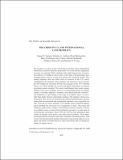| dc.description.abstract | The incidence of cancer in the United States and other major industrialized
nations has escalated to epidemic proportions over recent decades, and greater
increases are expected. While smoking is the single largest cause of cancer,
the incidence of childhood cancers and a wide range of predominantly nonsmoking-
related cancers in men and women has increased greatly. This
modern epidemic does not reflect lack of resources of the U.S. cancer
establishment, the National Cancer Institute and American Cancer Society;
the NCI budget has increased 20-fold since passage of the 1971 National
Cancer Act, while funding for research and public information on primary
prevention remains minimal. The cancer establishment bears major responsibility
for the cancer epidemic, due to its overwhelming fixation on damage
control—screening, diagnosis, treatment, and related molecular research—
and indifference to preventing a wide range of avoidable causes of cancer,
other than faulty lifestyle, particularly smoking. This mindset is based on a
discredited 1981 report by a prominent pro-industry epidemiologist, guesstimating
that environmental and occupational exposures were responsible for
only 5 percent of cancer mortality, even though a prior chemical industry
report admitted that 20 percent was occupational in origin. This report still
dominates public policy, despite overwhelming contrary scientific evidence
on avoidable causes of cancer from involuntary exposures to a wide range of
environmental carcinogens. Since 1998, the ACS has been planning to gain
control of national cancer policy, now under federal authority. These plans,
developed behind closed doors and under conditions of nontransparency, with
recent well-intentioned but mistaken bipartisan Congressional support, pose a
major and poorly reversible threat to cancer prevention and to winning the
losing war against cancer. | en_US |
